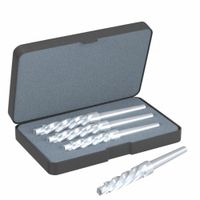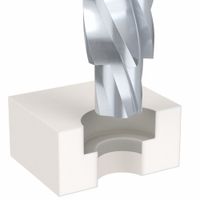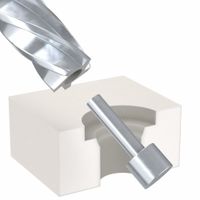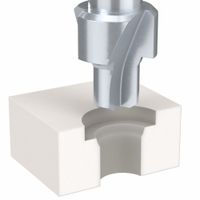Call +(254) 703 030 000 / 751 483 999 / 721 704 777
- Home
- Machining
- Drilling Holemaking
- Counterbores Port Tools
.....Read More
Frequently Asked Questions
What is the purpose of a counterbore?
A counterbore is a cylindrical flat-bottomed hole that enlarges another coaxial hole, typically used to allow the head of a bolt or screw to sit flush with or below the surface of the surrounding material. The primary purpose of a counterbore is to create a recess for the head of a fastener, ensuring that it does not protrude above the surface, which can be crucial for both functional and aesthetic reasons.
Functionally, a counterbore allows for a smooth, unobstructed surface, which is important in applications where the surface needs to be free of protrusions, such as in moving parts or assemblies that require a flat surface for other components to rest against. This can prevent interference with moving parts, reduce wear, and improve the overall integrity and performance of the assembly.
Aesthetically, counterboring provides a clean, professional appearance by hiding the fastener heads, which can be important in consumer products, furniture, and architectural applications where visual appeal is a consideration.
Additionally, counterbores can help distribute the load of the fastener more evenly across the surface, reducing the risk of material deformation or damage. This is particularly important in softer materials like wood or plastic, where the concentrated force of a fastener head could otherwise cause splitting or indentation.
Counterbores are typically created using a counterbore tool or bit, which is designed to cut a precise, flat-bottomed hole. These tools are available in various sizes to accommodate different fastener head dimensions and are often used in conjunction with drills or milling machines.
How do you choose the right size counterbore?
To choose the right size counterbore, follow these steps:
1. **Identify the Bolt or Screw Size**: Determine the diameter of the bolt or screw head that will sit in the counterbore. This is crucial as the counterbore must accommodate the head comfortably.
2. **Determine the Head Type**: Identify the type of head (e.g., hex, socket, or flat) as different head types require different counterbore dimensions.
3. **Select the Counterbore Diameter**: The counterbore diameter should be slightly larger than the diameter of the bolt or screw head to ensure a proper fit. Typically, the counterbore diameter is about 1.5 times the diameter of the bolt or screw.
4. **Choose the Counterbore Depth**: The depth should be sufficient to allow the bolt or screw head to sit flush or below the surface of the material. This is often equal to or slightly greater than the height of the bolt or screw head.
5. **Consider Material Thickness**: Ensure the material is thick enough to accommodate the counterbore without compromising structural integrity.
6. **Check Standards and Specifications**: Refer to industry standards (e.g., ANSI, ISO) for recommended counterbore sizes for specific bolt or screw sizes.
7. **Use a Counterbore Chart**: Consult a counterbore size chart that matches the bolt or screw size to the appropriate counterbore dimensions.
8. **Test Fit**: If possible, perform a test fit with a sample piece to ensure the counterbore size is correct before proceeding with the final workpiece.
By following these steps, you can select the appropriate counterbore size to ensure a secure and aesthetically pleasing fit for your bolts or screws.
What materials can counterbores be used on?
Counterbores can be used on a variety of materials, including:
1. **Metals**: Counterbores are commonly used on metals such as steel, aluminum, brass, and copper. These materials are often encountered in industrial and manufacturing settings where precise, flush-mounted fasteners are required.
2. **Wood**: In woodworking, counterbores are used to create recesses for screw heads, allowing them to sit flush or below the surface. This is particularly useful in furniture making and cabinetry.
3. **Plastics**: Counterbores can be used on various plastics, including acrylic, polycarbonate, and PVC. These materials are often used in applications where lightweight and corrosion-resistant properties are needed.
4. **Composites**: Counterbores can be applied to composite materials, such as fiberglass and carbon fiber. These materials are used in industries like aerospace and automotive for their strength-to-weight ratio.
5. **Ceramics**: Although more challenging due to their brittleness, counterbores can be used on certain ceramics with the appropriate tools and techniques, often in specialized applications.
6. **Rubber and Elastomers**: In some cases, counterbores can be used on softer materials like rubber, though this requires careful handling to avoid tearing or deforming the material.
The choice of counterbore tool and technique depends on the material's hardness, brittleness, and other properties. Proper tool selection, such as using carbide or high-speed steel counterbores, and appropriate cutting speeds and feeds are crucial for achieving the desired results without damaging the material.
What is the difference between a counterbore and a countersink?
A counterbore and a countersink are both machining processes used to create recesses in a material, typically metal or wood, to allow fasteners like screws or bolts to sit flush with or below the surface. However, they differ in design, purpose, and application.
A counterbore is a cylindrical, flat-bottomed hole that enlarges another hole, allowing the head of a bolt or screw to sit flush with or below the surface. It is typically used for socket head cap screws and bolts. The counterbore hole has a larger diameter than the original hole and is usually created using a counterbore tool with a pilot to guide it into the existing hole. This process is essential when the fastener head needs to be hidden or when a smooth surface is required for aesthetic or functional reasons.
A countersink, on the other hand, is a conical hole cut into the material, allowing the head of a countersunk screw to sit flush with or below the surface. The angle of the countersink typically matches the angle of the screw head, commonly 82 or 90 degrees. Countersinking is used to prevent the screw head from protruding, which can be important for both functional and aesthetic reasons. It is often used in woodworking, metalworking, and applications where a smooth surface is necessary.
In summary, the primary difference lies in their shapes and applications: counterbores create flat-bottomed recesses for bolt heads, while countersinks create conical recesses for screw heads. Both processes ensure that fasteners do not interfere with the surface of the material, but they are used for different types of fasteners and applications.
How do you use a counterbore tool?
To use a counterbore tool, follow these steps:
1. **Select the Right Tool**: Choose a counterbore tool that matches the diameter of the screw head and the pilot hole. Ensure the tool is compatible with the material you are working on.
2. **Prepare the Workpiece**: Secure the workpiece firmly using a vise or clamps to prevent movement during the operation.
3. **Drill the Pilot Hole**: Use a drill bit to create a pilot hole where the screw will be inserted. The pilot hole should be slightly smaller than the screw's diameter.
4. **Set the Counterbore Tool**: Attach the counterbore tool to a drill or a drill press. Adjust the depth stop if available to control the depth of the counterbore.
5. **Align the Tool**: Position the counterbore tool over the pilot hole. Ensure it is perpendicular to the workpiece to avoid an uneven counterbore.
6. **Drill the Counterbore**: Start the drill at a low speed to maintain control. Apply steady pressure and drill until the desired depth is reached. The counterbore should be deep enough to allow the screw head to sit flush or below the surface.
7. **Check the Fit**: Insert the screw into the counterbore to ensure it fits properly. The screw head should be flush with or slightly below the surface of the workpiece.
8. **Clean Up**: Remove any debris or burrs from the counterbore using a deburring tool or sandpaper for a clean finish.
9. **Final Inspection**: Verify the alignment and depth of the counterbore to ensure it meets the required specifications.
By following these steps, you can effectively use a counterbore tool to create a recess for screw heads, ensuring a smooth and professional finish.
Can counterbores be used with a drill press?
Yes, counterbores can be used with a drill press. A drill press provides the stability and precision needed for counterboring operations, which involve enlarging a portion of a pre-drilled hole to allow the head of a bolt or screw to sit flush with or below the surface of the material. When using a counterbore with a drill press, the workpiece should be securely clamped to prevent movement, ensuring accuracy and safety. The drill press's adjustable speed settings allow for optimal control over the cutting process, reducing the risk of tool damage or material tear-out. Additionally, the drill press's depth stop feature can be used to achieve consistent counterbore depths across multiple holes.
What are the advantages of using a counterbore with a removable pilot?
A counterbore with a removable pilot offers several advantages:
1. **Versatility**: The removable pilot allows the counterbore to be used with different pilot sizes, making it adaptable to various hole diameters. This flexibility reduces the need for multiple counterbores, saving costs and storage space.
2. **Precision**: The pilot ensures accurate alignment with the pre-drilled hole, resulting in a concentric counterbore. This precision is crucial for applications requiring tight tolerances, such as in mechanical assemblies where bolt heads or fasteners must sit flush.
3. **Ease of Use**: The removable pilot simplifies the process of changing pilots to match different hole sizes. This ease of interchangeability enhances efficiency, especially in production environments where quick adjustments are necessary.
4. **Cost-Effectiveness**: By using a single counterbore body with multiple pilots, the need to purchase and maintain a large inventory of fixed-pilot counterbores is reduced. This cost-saving is beneficial for both small workshops and large manufacturing facilities.
5. **Reduced Wear and Tear**: The pilot guides the counterbore, minimizing lateral forces and reducing wear on the cutting edges. This prolongs the tool's lifespan and maintains cutting performance over time.
6. **Improved Surface Finish**: The stability provided by the pilot helps achieve a smoother surface finish in the counterbored area, which is important for both aesthetic and functional reasons, such as ensuring proper seating of fasteners.
7. **Convenience in Maintenance**: If a pilot becomes worn or damaged, it can be replaced without discarding the entire counterbore tool. This modularity simplifies maintenance and reduces downtime.
Overall, a counterbore with a removable pilot enhances operational flexibility, precision, and cost-efficiency, making it a valuable tool in various machining and manufacturing applications.



